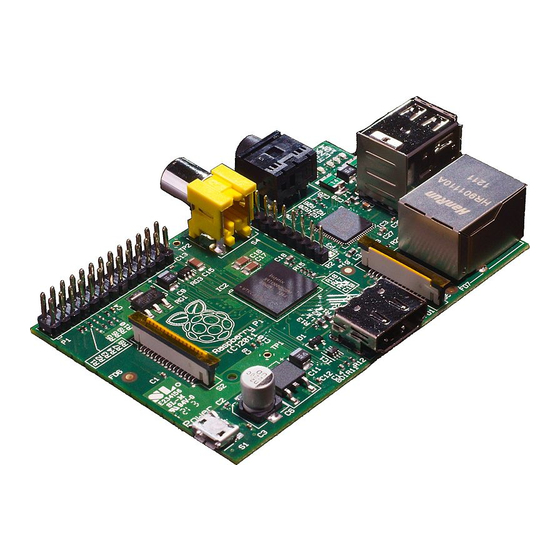
Advertisement
Quick Links
Download this manual
See also:
User Manual
2b
Connect display
1
If not using HDMI,
plug in your analogue
TV or display
1
Insert SD card
See page 3 for how to
prepare the SD card
5
Power up
Plug in the micro USB
power supply
3
Connect input
Plug in a USB keyboard
and mouse
2a
Connect display
Plug in your digital TV
or monitor
4
Connect network
Connect to your wired
network [optional]
Quick start
1
Advertisement

Summary of Contents for Raspberry Pi Raspberry Pi
-
Page 1: Quick Start
Connect display Connect input If not using HDMI, Plug in a USB keyboard plug in your analogue and mouse TV or display Connect network Connect to your wired network [optional] Quick start Insert SD card See page 3 for how to prepare the SD card Power up Connect display... - Page 2 • Many mobile phone chargers are suitable—check the label on the plug. • If your supply provides less than 5V then your Raspberry Pi may not work at all, or it may behave erratically. Be wary of very cheap chargers: some are not what they claim to be.
- Page 3 Preparing your SD card for the Raspberry Pi In order to use your Raspberry Pi, you will need to install an Operating System (OS) onto an SD card. An Operating System is the set of basic programs and utilities that allow your computer to run; examples include Windows on a PC or OSX on a Mac. These instructions will guide you through installing a recovery program on your SD card that will allow you to easily install different OS’s and to recover your card if you break it. 1. Insert an SD card that is 4GB or greater in size into your computer 2. Format the SD card so that the Pi can read it a. Windows i. Download the SD Association's Formatting Tool from https://www.sdcard.org/downloads/formatter_4/eula_windows/ ii. Install the Formatting Tool on your machine iii. Run the Formatting Tool iv. Set "FORMAT SIZE ADJUSTMENT" option to "ON" in the "Options" menu v. Check that the SD card you inserted matches the one selected by the Tool vi. Click the “Format” button b. Mac i. Download the SD Association's Formatting Tool from https://www.sdcard.org/downloads/formatter_4/eula_mac/ ii. Install the Formatting Tool on your machine iii. Run the Formatting Tool iv. Select “Overwrite Format” v. Check that the SD card you inserted matches the one selected by the Tool vi. Click the “Format” button c.
